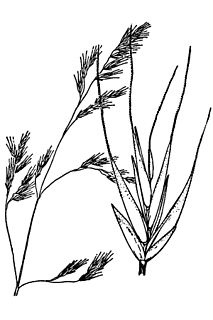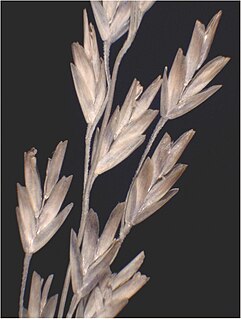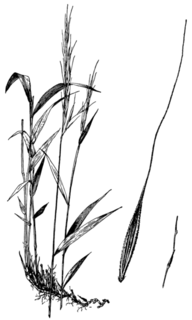
Bromus secalinus is a species of bromegrass known as rye brome. The specific epithet secalinus is Latin, meaning "rye-like". The fruits are hard, rounded glumes that appear superficially similar to the rye grain, which gives the brome its common and scientific name. The grass has a diploid number of 28.

Festuca occidentalis is a species of grass known as western fescue. It is native to much of the northern half of North America and is most widely distributed in the west. It is most often found in forest and woodland habitat. The specific epithet occidentalis is Latin, meaning "western".

Bromus catharticus is a species of brome grass known by the common names rescuegrass, grazing brome, prairie grass, and Schrader's bromegrass. The specific epithet catharticus is Latin, meaning cathartic. The common name rescuegrass refers to the ability of the grass to provide forage after harsh droughts or severe winters. The grass has a diploid number of 42.

Bromus ciliatus is a species of brome grass known by the common name fringed brome. It is native to most of North America, including most of Canada, most of the United States except for some portions of the South, and northern Mexico. It is a plant of many habitats, including temperate coniferous forest. The specific epithet ciliatus is Latin for "ciliate", referring to the delicate hairs of the leaf blades.

Hypericum mutilum is a species of St. John's wort known by the common name dwarf St. John's wort. It is native to parts of North America and is present in other parts as an introduced species. It is an annual or perennial herb taking a multibranched erect form up to about 60 centimeters tall. The oval green leaves are one or two centimeters long and are covered in tiny glands. The inflorescence is a compound cyme of tiny flowers. H. mutilum subsp. mutilum and subsp. boreale have a diploid number of 16, and H. mutilum subsp. boreale can have a diploid number of 18.

Bromus kalmii, the Arctic brome or prairie brome, is a species of brome grass. It is a native bunchgrass in the North-central and Northeastern United States, the Great Lakes region, and eastern Canada. The specific epithet kalmii refers to its discoverer Pehr Kalm.

Festuca vivipara, the viviparous sheep's-fescue, is a species of grass native to northern Europe, northern Asia, and subarctic North America. The specific epithet vivipara is Latin, referring to the florets' alteration to leafy tufts. The plant can have a diploid number of 28, 49, 56, or 63, though numbers of 21, 35, and 42 have also been reported.
Hypericum cuisinii is a perennial herb in the genus Hypericum, in the section Adenosepalum. The herb has pale yellow flowers and occurs in Greece and Turkey.

Bromus latiglumis, the earlyleaf brome, is a grass native to North America. The specific epithet latiglumis is Latin for "broad-glumed", referring to the wide glumes.

Bromus nottowayanus, the Nottoway Valley brome or satin brome, is a brome grass native to North America. The specific epithet nottowayanus refers to the Nottoway Valley. The grass has a diploid number of 14.

Bromus japonicus, the Japanese brome, is an annual brome grass native to Eurasia. The grass has a diploid number of 14.

Hypericum majus, the greater Canadian St. John's wort, is a perennial herb native to North America. The specific epithet majus means "larger". The plant has a diploid number of 16.
Vulpia elliotea, known by the common name sand fescue or squirreltail fescue, is an annual grass native to the southeastern United States. Its specific epithet elliotea is named for its discoverer, Stephen Elliott.

Puccinellia fasciculata, or Borrer's saltmarsh grass, is an annual grass native to coasts of Europe and introduced to the northern east coast of North America. Its diploid number is 28.
Puccinellia laurentiana is a perennial grass which grows on gravelly seashores in south-eastern Canada. Its specific epithet "laurentiana" refers to the Gulf of St. Lawrence, where it grows.
Puccinellia lucida is a perennial grass which grows in south-eastern Canada and occasionally elsewhere in the United States. Its specific epithet lucida means "shining", referring to the plant's lustrous glumes.

Glyceria melicaria, the melic mannagrass or northeastern mannagrass, is a perennial grass found in the eastern United States. Its specific epithet melicaria means "similar to Melica". Its diploid number is 40.
Poa subcaerulea is a perennial grass occurring in North America and Europe. Its specific epithet "subcaerulea" means "bluish". Its diploid number varies between 54 and 109.
Poa alpigena is a grass occurring in mountainous regions. Its specific epithet "alpigena" means "growing in the alpine".

Brachyelytrum erectum, known as the southern shorthusk or the southern long-awned woodgrass, is an annual grass native to North America. Its specific epithet "erectum" refers to the erect culms of the grass. Its diploid number is 22.













